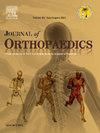Pre-arthritic coronal plane alignment predicted by the arithmetic hip-knee-ankle angle (aHKA) and the Flexion Extension Balancing Algorithm (FEBA) for Primary Total Knee Arthroplasty (TKA)
IF 1.5
Q3 ORTHOPEDICS
引用次数: 0
Abstract
Background
Given the relative rate of dissatisfaction following total knee arthroplasty (TKA) and the need to further improve outcomes for all patients, various surgical methods have been developed that aim to restore the pre-arthritic alignment of the knee and lower limb. Common to these methodologies is a need to determine the pre-arthritic alignment of the knee and limb, thus producing defined targets for surgery. The aim of this paper was to compare the predicted pre-arthritic constitutional alignment of knee and lower limb calculated by the Flexion Extension Balancing Algorithm (FEBA) and the arithmetic HKA (aHKA) methods. The aHKA has been proposed as a means of accurately estimating the constitutional alignment of a knee and lower limb.
Methods
We calculated the proposed pre-arthritic alignment of 78 knees immediately prior to TKA surgery based on calculations using both methods. The results produced by the FEBA planning system (fHKA) were compared to the coronal plane alignment proposed by the aHKA process.
Results
No significant difference was demonstrated between the pre-arthritic alignments calculated by the two methods. The mean aHKA was −1.5° (SD 3.38°; range −7.9°–6.9°) and the mean fHKA was −1.1° (SD 2.96°; range −8.1°–7.5°). The mean angular difference between the methods was 0.4° ±1.94; p = 0.146. The two methods produced alignment measurements with a strong positive correlation r = 0.82 p < 0.0001; R2 = 0.674.
Conclusions
There is a high correlation between the proposed pre-arthritic knee alignments when comparing the FEBA and arithmetic HKA methods. The pre-arthritic alignment of the knee is difficult to know with certainty. The use of both calculation methods will deliver a potential target zone for TKA knee alignment that makes use of all residual anatomy.
用算术髋关节-膝关节-踝关节角(aHKA)和屈伸平衡算法(FEBA)预测原发性全膝关节置换术(TKA)的关节前冠状面对齐
背景:考虑到全膝关节置换术(TKA)后的相对不满意率以及进一步改善所有患者预后的需要,各种手术方法已经被开发出来,旨在恢复膝关节和下肢的关节炎前对齐。这些方法的共同点是需要确定关节炎前膝关节和肢体的排列,从而确定手术的目标。本文的目的是比较屈伸平衡算法(FEBA)和算术HKA (aHKA)方法预测的膝关节和下肢关节炎前的体质排列。aHKA已被提议作为一种准确估计膝关节和下肢的体质对齐的手段。方法基于两种方法的计算,我们计算了78个膝关节在TKA手术前的建议关节炎前对齐。将FEBA规划系统(fHKA)得到的结果与aHKA过程提出的冠状面对准结果进行了比较。结果两种方法计算的关节关节炎前关节位无明显差异。平均aHKA为- 1.5°(SD 3.38°;范围- 7.9°-6.9°),平均fHKA为- 1.1°(SD 2.96°;范围−8.1°-7.5°)。两种方法的平均角度差为0.4°±1.94;p = 0.146。两种方法产生的对准测量结果具有很强的正相关r = 0.82 p <;0.0001;r2 = 0.674。结论在比较FEBA和算数HKA方法时,提出的关节炎前膝关节对齐有很高的相关性。关节炎前膝关节的位置很难确定。使用这两种计算方法将提供TKA膝关节对齐的潜在目标区域,利用所有剩余解剖结构。
本文章由计算机程序翻译,如有差异,请以英文原文为准。
求助全文
约1分钟内获得全文
求助全文
来源期刊

Journal of orthopaedics
ORTHOPEDICS-
CiteScore
3.50
自引率
6.70%
发文量
202
审稿时长
56 days
期刊介绍:
Journal of Orthopaedics aims to be a leading journal in orthopaedics and contribute towards the improvement of quality of orthopedic health care. The journal publishes original research work and review articles related to different aspects of orthopaedics including Arthroplasty, Arthroscopy, Sports Medicine, Trauma, Spine and Spinal deformities, Pediatric orthopaedics, limb reconstruction procedures, hand surgery, and orthopaedic oncology. It also publishes articles on continuing education, health-related information, case reports and letters to the editor. It is requested to note that the journal has an international readership and all submissions should be aimed at specifying something about the setting in which the work was conducted. Authors must also provide any specific reasons for the research and also provide an elaborate description of the results.
 求助内容:
求助内容: 应助结果提醒方式:
应助结果提醒方式:


